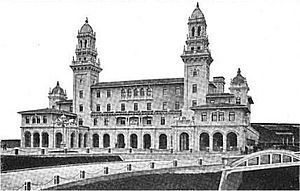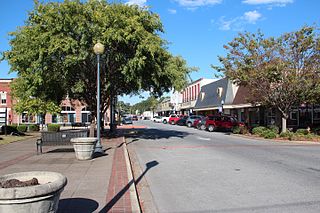
Rockmart is a town in Polk County, Georgia, United States. Its population was 4,732 at the 2020 census. It developed as a railroad depot town when the Southern Railway built a station in the area. The community was incorporated in 1872, and was named from abundant deposits of slate in the area. The Rockmart Downtown Historic District is listed on the National Register of Historic Places.
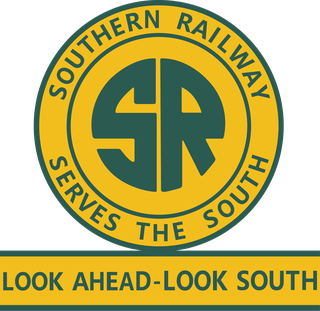
The Southern Railway was a class 1 railroad based in the Southern United States between 1894 and 1982, when it merged with the Norfolk and Western Railway (N&W) to form the Norfolk Southern Railway. The railroad was the product of nearly 150 predecessor lines that were combined, reorganized and recombined beginning in the 1830s, formally becoming the Southern Railway in 1894.

The Seaboard Air Line Railroad, which styled itself as "The Route of Courteous Service", was an American railroad that existed from April 14, 1900, until July 1, 1967, when it merged with the Atlantic Coast Line Railroad, its longtime rival, to form the Seaboard Coast Line Railroad. Predecessor railroads dated from the 1830s and reorganized extensively to rebuild after the American Civil War. The company was headquartered in Norfolk, Virginia, until 1958, when its main offices were relocated to Richmond, Virginia. The Seaboard Air Line Railway Building in Norfolk's historic Freemason District still stands and has been converted into apartments.

The Louisville and Nashville Railroad, commonly called the L&N, was a Class I railroad that operated freight and passenger services in the southeast United States.

The Chattanooga Choo-Choo Hotel in Chattanooga, Tennessee, is a former railroad station once owned and operated by the Southern Railway. Listed on the National Register of Historic Places, the station is currently operated as a hotel, and is a member of Historic Hotels of America, part of the National Trust for Historic Preservation.
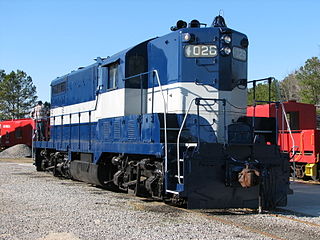
The Georgia Railroad and Banking Company also seen as "GARR", was a historic railroad and banking company that operated in the U.S. state of Georgia. In 1967 it reported 833 million revenue-ton-miles of freight and 3 million passenger-miles; at the end of the year it operated 331 miles (533 km) of road and 510 miles (820 km) of track.

The Central of Georgia Railway started as the Central Rail Road and Canal Company in 1833. As a way to better attract investment capital, the railroad changed its name to Central Rail Road and Banking Company of Georgia. This railroad was constructed to join the Macon and Western Railroad at Macon, Georgia, in the United States, and run to Savannah. This created a rail link from Chattanooga, on the Tennessee River, to seaports on the Atlantic Ocean. It took from 1837 to 1843 to build the railroad from Savannah to the eastern bank of the Ocmulgee River at Macon; a bridge into the city was not built until 1851.

The Nancy Hanks was a popular Central of Georgia Railway and later Southern Railway passenger train in Georgia running between Atlanta and Savannah. It was named after a race horse that was named for Abraham Lincoln's mother. The name is even older than the mid-20th century train derived from that of a short-lived but famous steam special, the Nancy Hanks. The earlier Nancy operated in 1892 and 1893.

The Waycross Air Line Railroad, chartered in 1887, was an air-line railroad in Georgia. It began operations between Waycross and Sessoms in 1890. In 1901, the railroad had extended as far as Fitzgerald, Georgia, at which time its charter was amended for an extension to Birmingham, Alabama, and it was renamed the Atlantic and Birmingham Railroad. That company purchased the Tifton and Northeastern Railroad and Tifton, Thomasville and Gulf Railway on December 3, 1903, changing its name to the Atlantic and Birmingham Railway. In 1906, the Atlantic and Birmingham Railway was in turn purchased by the Atlanta, Birmingham and Atlantic Railway, which continued expansion towards Birmingham.
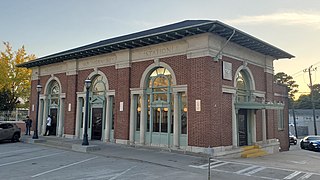
Atlanta Peachtree Station is a train station in Atlanta, Georgia. It is currently a service stop for Amtrak's Crescent passenger train. The street address is 1688 Peachtree Road, Northwest, in the Brookwood section of town between Buckhead and Midtown.

The Boca Express Train Museum, operated by the Boca Raton Historical Society, is housed in a restored 1930 Florida East Coast Railway (FEC) train station in Boca Raton, Florida. designed by Chester G. Henninger, built for Clarence H. Geist. It is located at 747 South Dixie Highway, off U.S. 1. On October 24, 1980, it was added to the U.S. National Register of Historic Places.

Birmingham station is a train station in Birmingham, Alabama. It is a service stop for Amtrak's Crescent, which provides daily service between New York City, Atlanta, and New Orleans. The current station is located on the site of another station originally built by the Louisville and Nashville Railroad in 1960, although Amtrak did not use the building itself, which was torn down in the 2000s.

The Birmingham Terminal Station, completed in 1909, was the principal railway station for Birmingham, Alabama until the 1950s. It was demolished in 1969, and its loss still serves as a rallying image for local preservationists.

The Union Station built in 1930 in Atlanta was the smaller of two principal train stations in downtown, Terminal Station being the other. It was the third "union station" or "union depot", succeeding the 1853 station, burned in mid-November 1864 when Federal forces left Atlanta for the March to the Sea, and the 1871 station.

The Royal Palm was a named train of the Southern Railway that ran from Cincinnati, Ohio, to Jacksonville, Florida, and then on the Florida East Coast Railway's East Coast Champion to Miami, Florida. The train was discontinued in 1970.
The South Wind was a named passenger train equipped and operated jointly by the Pennsylvania Railroad, the Louisville and Nashville Railroad, the Atlantic Coast Line Railroad, and the Florida East Coast Railway. The South Wind began operations in December 1940, providing streamliner service between Chicago, Illinois and Miami, Florida. This was one of three new seven-car, all-coach streamliners operating in coordination every third day along different routes between Chicago and Miami. The other two longest enduring Chicago-Florida trains were the City of Miami and the Dixie Flagler. The South Wind remained in service through the creation of Amtrak in 1971.
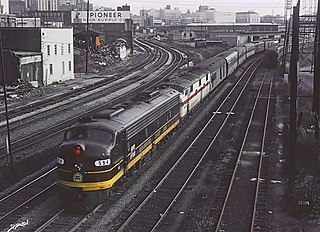
The Silver Comet was a streamlined passenger train inaugurated on May 18, 1947, by the Seaboard Air Line Railroad. Before its inaugural run, the new train was christened by actress Jean Parker at Pennsylvania Station in New York City. The train succeeded the SAL's Cotton States Special, which took the same route and which like the Silver Comet left the northeast at midday and arrived at Birmingham in the late morning.
The Ponce de Leon was a named train of the Southern Railway which ran from Cincinnati, Ohio, to Jacksonville, Florida, from 1924 to the mid-1960s.

Terminal Station, Macon, Georgia, is a railroad station that was built in 1916, and is located on 5th St. at the end of Cherry St. It was designed in the Beaux-Arts style by architect Alfred T. Fellheimer (1875–1959), prominent for his design of Grand Central Terminal in New York City in 1903. The station building is part of the Macon Historic District, which is listed on the National Register of Historic Places. While no longer an active train station, it has been the location of the Macon Transit Authority bus hub since 2014.

Columbus Union Station was a union station in Columbus, Georgia. The building was built in 1901 and was designed in the Second Empire style by the architectural firm, Bruce and Morgan. The station hosted the Central Railroad of Georgia, the Seaboard Air Line Railroad and the Southern Railway. It was located at 1200 Sixth Avenue, directly north of 12th Street, Columbus.
